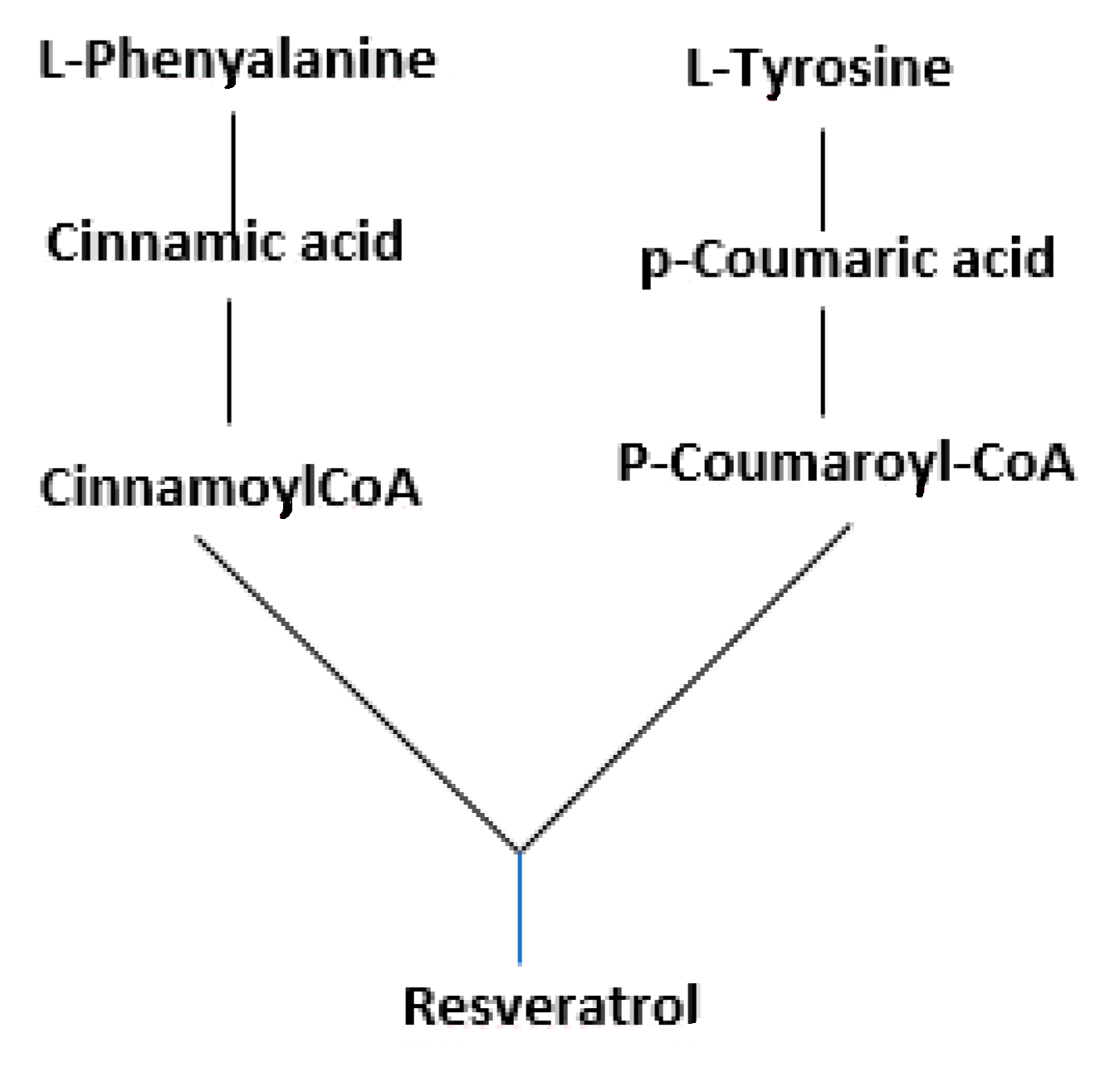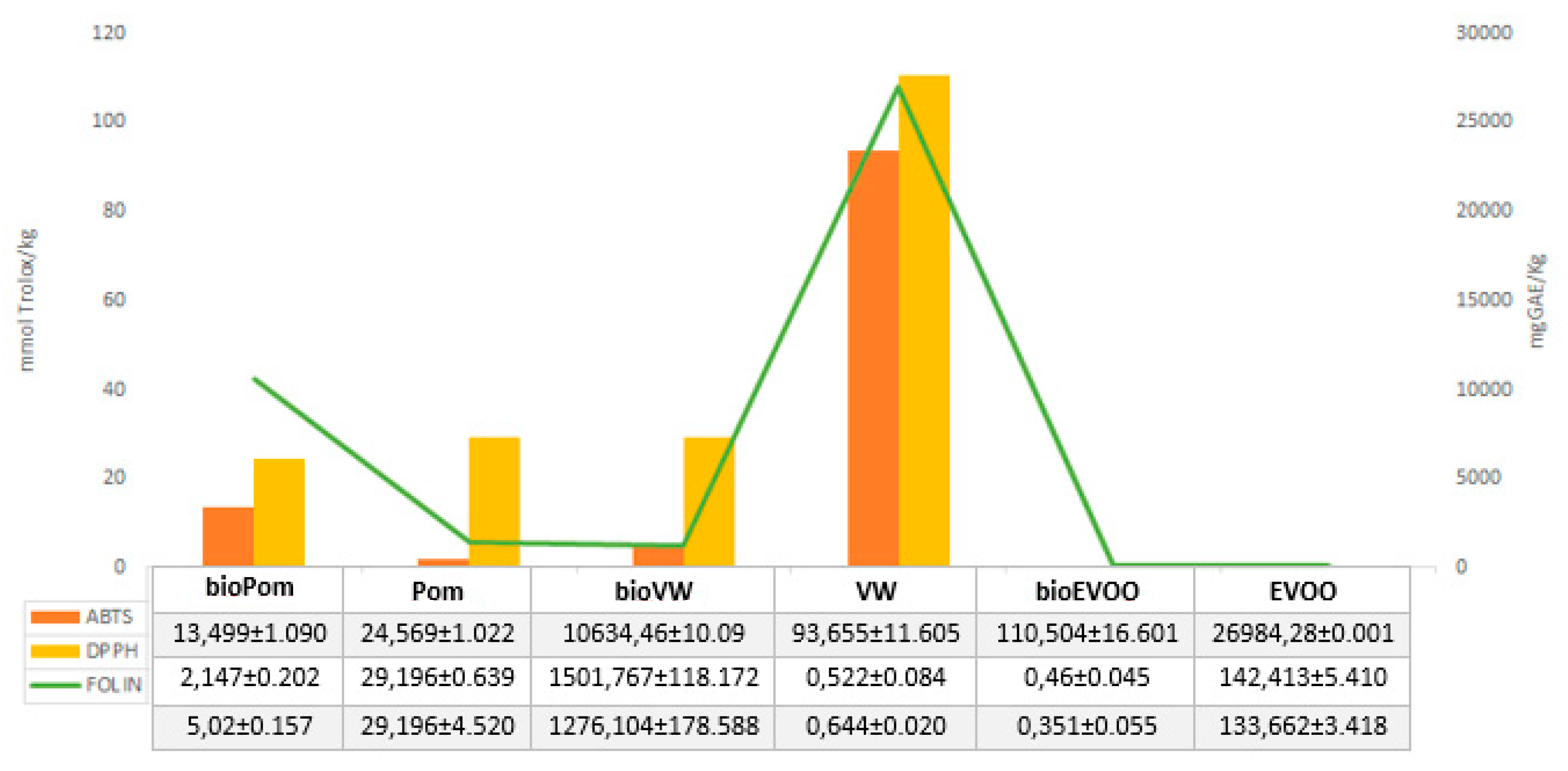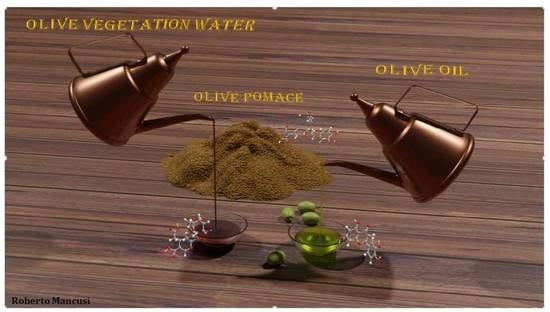An Environmentally Friendly Practice Used in Olive Cultivation Capable of Increasing Commercial Interest in Waste Products from Oil Processing
Abstract
1. Introduction
2. Materials and Methods
2.1. Plant Material
2.2. Fungal Material
2.3. Oil Production
2.4. Chemicals
2.5. Analytical Methods
2.5.1. The Phenolics Extraction
2.5.2. Q Exactive Orbitrap LC-MS/MS Method
2.5.3. Method Validation of the Phenolics Dosage
2.5.4. Total Polyphenol Content
2.5.5. The Antioxidant Activity Evaluation
DPPH Method
ABTS Method
2.6. Statistical Analysis
3. Results
3.1. The Phenolics Characterization
3.2. The Phenolics Dosage
3.3. Total Phenolic Concentration and Antioxidant Activity
4. Discussion
5. Conclusions
Author Contributions
Funding
Conflicts of Interest
References
- Dini, I.; Graziani, G.; Fedele, F.L.; Sicari, A.; Vinale, F.; Castaldo, L.; Ritieni, A. Effects of Trichoderma biostimulation on the phenolic profile of extra-virgin olive oil and olive oil by-products. Antioxidants 2020, 9, 284. [Google Scholar] [CrossRef] [PubMed]
- Niaounakis, M.; Halvadakis, C.P. Olive-Mill Waste Management: Literature Review and Patent Survey, 1st ed.; Typothito-George Dardanos: Athens, Greece, 2004; pp. 131–146. [Google Scholar]
- Morillo, J.A.; Antizar-Ladislao, B.; Monteoliva-Sanchez, M.; Ramos-Cormenzana, A.; Russell, N.J. Bioremediation and biovalorisation of olive mill wastes. Appl. Microbiol. Biotechnol. 2009, 82, 25–39. [Google Scholar] [CrossRef] [PubMed]
- Romero-García, J.M.; Niño, L.; Martínez-Patiño, C.; Álvarez, C.; Castro, E.; Negro, M.J. Biorefinery based on olive biomass. State of the art and future trends. Bioresour. Technol. 2014, 159, 421–432. [Google Scholar] [CrossRef] [PubMed]
- Saviozzi, A.; Riffaldi, R.; Levi-Minzi, R.; Scagnozzi, A.; Vanni, G. Decomposition of vegetation-water sludge in soil. Bioresour. Technol. 1993, 44, 223–228. [Google Scholar] [CrossRef]
- Qdais, H.A.; Alshraideh, H. Selection of management option for solid waste from olive oil industry using the analytical hierarchy process. J. Mater. Cycles Waste Manag. 2014, 18, 1–9. [Google Scholar] [CrossRef]
- Elkacmi, R.; Kamil, N.; Bennajah, M. Separation and purification of high purity products from three different olive mill wastewater samples. J. Environ. Chem. Eng. 2017, 5, 829–837. [Google Scholar] [CrossRef]
- Cioffi, G.; Pesca, M.S.; De Caprariis, P.; Braca, A. Phenolic compounds in olive oil and olive pomace from Cilento (Campania, Italy) and their antioxidant activity. Food Chem. 2010, 121, 105–111. [Google Scholar] [CrossRef]
- Miraglia, D.; Esposto, S.; Branciari, R.; Urbani, S.; Servili, M.; Perucci, S.; Ranucci, D. Effect of a Phenolic extract from olive vegetation water on fresh salmon steak quality during storage. Ital. J. Food Saf. 2016, 5, 224–228. [Google Scholar] [CrossRef]
- Papanikolaou, C.; Melliou, E.; Magiatis, P. Olive Oil Phenols. In Functional Foods; Intech Open: London, UK, 2019; pp. 9–13. [Google Scholar]
- Halliwell, B. How to characterize a biological antioxidant. Free Radic. Res. Commun. 1990, 9, 1–32. [Google Scholar] [CrossRef] [PubMed]
- Halliwell, B. Antioxidants in human health and disease. Annu. Rev. Nutr. 1996, 16, 33–50. [Google Scholar] [CrossRef] [PubMed]
- Roselló-Soto, E.; Parniakov, O.; Deng, Q.; Patras, A.; Koubaa, M.; Grimi, N.; Boussetta, N.; Tiwari, B.K.; Vorobiev, E.; Lebovka, N.; et al. Application of Non-conventional Extraction Methods: Toward a Sustainable and Green Production of Valuable Compounds from Mushrooms. Food Eng. Rev. 2016, 8, 214–234. [Google Scholar] [CrossRef]
- Saija, A.; Uccella, N. Olive biophenols: Functional effects onhuman wellbeing. Trends Food Sci. Technol. 2000, 11, 357–363. [Google Scholar] [CrossRef]
- Dini, I.; Laneri, S. Nutricosmetics: A brief overview. Phytother. Res. 2019, 33, 3054–3063. [Google Scholar] [CrossRef] [PubMed]
- Vita, J.A. Polyphenols and cardiovascular disease: Effects on endothelial and platelet function. Am. J. Clin. Nutr. 2005, 81, 292S–297S. [Google Scholar] [CrossRef]
- Stoclet, J.C.; Chataigneau, T.; Ndiaye, M.; Oak, M.H.; El Bedoui, J.; Chataigneau, M.; Shini-Kerth, V.B. Vascular protection by dietary polyphenols. Eur. J. Pharm. 2004, 500, 299–313. [Google Scholar] [CrossRef]
- Montesano, D.; Rocchetti, G.; Cossignani, L.; Senizza, B.; Pollini, L.; Lucini, L.; Blasi, F. Untargeted Metabolomics to Evaluate the Stability of Extra-Virgin Olive Oil with Added Lycium barbarum Carotenoids during Storage. Foods 2019, 8, 179. [Google Scholar] [CrossRef]
- Ruzzolini, J.; Peppicelli, S.; Andreucci, E.; Bianchini, F.; Scardigli, A.; Romani, A.; La Marca, G.; Nediani, C.; Calorini, L. Oleuropein, the Main Polyphenol of Olea europaea Leaf Extract, Has an Anti-Cancer Effect on Human BRAF Melanoma Cells and Potentiates the Cytotoxicity of Current Chemotherapies. Nutrients 2018, 10, 1950. [Google Scholar] [CrossRef]
- Bianco, A.; Muzzalupo, I.; Piperno, A.; Romeo, G.; Uccella, N. Bioactive derivatives of oleuropein from olive fruits. J. Agric. Food Chem. 1999, 47, 3531–3534. [Google Scholar] [CrossRef]
- Capasso, R.; Evidente, A.; Schivo, L.; Orru, G.; Marcialis, M.A.; Cristinzio, G. Antibacterial polyphenols from olive oil mill wastewaters. J. Appl. Bacteriol. 1995, 79, 393–398. [Google Scholar] [CrossRef]
- Ramos-Cormenzana, A.; Juárez-Jiménez, B.; Garcia-Pareja, M.P. Antimicrobial activity of olive mill waste-waters (alpechin) and biotransformed olive oil mill wastewater. Int. Biodet. Biodeg. 1996, 38, 283–290. [Google Scholar] [CrossRef]
- Bulgari, R.; Franzoni, G.; Ferrante, A. Biostimulants application in horticultural crops under abiotic stress conditions. Agronomy 2019, 9, 306. [Google Scholar] [CrossRef]
- Ertani, A.; Schiavon, M.; Muscolo, A.; Nardi, S. Alfalfa plant-derived biostimulant stimulate short-term growth of salt stressed Zea mays L. plants. Plant Soil 2013, 364, 145–158. [Google Scholar] [CrossRef]
- Herrero, M.; Temirzoda, T.N.; Segura-Carretero, A.; Quirantes, R.; Plaza, M.; Ibañez, E. New possibilities for the valorization of olive oil by-products. J. Chromatogr. A 2011, 1218, 7511–7520. [Google Scholar] [CrossRef] [PubMed]
- Pascale, A.; Vinale, F.; Manganiello, G.; Nigro, M.; Lanzuise, S.; Ruocco, M.; Marra, R.; Lombardi, N.; Woo, S.L.; Lorito, M. Trichoderma and its secondary metabolites improve yield and quality of grapes. Crop Prot. 2017, 92, 176–181. [Google Scholar] [CrossRef]
- Haddadin, M.S.Y.; Haddadin, J.; Arabiyat, O.I.; Hattar, B. Biological conversion of olive pomace into compost by using Trichoderma harzianum and Phanerochaete chrysosporium. Bioresour. Technol. 2009, 100, 4773–4782. [Google Scholar] [CrossRef]
- Vázquez Roncero, A. Les polyphenols de l’huile d’olive et leur influence sur les caracteristiques de l’huile. Rev. Fr. Corps Gras. 1978, 25, 21–26. [Google Scholar]
- Gao, X.; Bjork, L.; Trajkovski, V.; Uggla, M. Evaluation of antioxidant activities of rosehip ethanol extracts in different test systems. J. Agric. Food Chem. 2000, 80, 2021–2027. [Google Scholar] [CrossRef]
- Brand-Williams, W.; Cuvelier, M.E.; Berset, C. Use of a free radical method to evaluate antioxidant activity. LWT Food Sci. Technol. 1995, 28, 25–30. [Google Scholar] [CrossRef]
- Re, R.; Pellegrini, N.; Proteggente, A.; Pannala, A.; Yang, M.; Rice-Evans, C. Antioxidant activity applying an improved ABTS radical cation decolorization assay. Free Radic. Biol. Med. 1999, 26, 1231–1237. [Google Scholar] [CrossRef]
- AOAC. Appendix F: Guidelines for Standard Method Performance Requirements (SMPR). In AOAC Official Methods of Analysis; AOAC: Rockville, MD, USA, 2012. [Google Scholar]
- Oksana, S.; Marian, B.; Mahendraand, R.; Bo, S.H. Plant phenolic compounds for food, pharmaceutical, and cosmetiсs production. J. Med. Plants Res. 2012, 6, 2526–2539. [Google Scholar]
- Tafuri, S.; Cocchia, N.; Carotenuto, D.; Vassetti, A.; Staropoli, A.; Mastellone, V.; Peretti, V.; Ciotola, F.; Albarella, S.; Del Prete, C.; et al. Chemical Analysis of Lepidium meyenii (Maca) and Its Effects on Redox Status and on Reproductive Biology in Stallions. Molecules 2019, 24, 1981. [Google Scholar] [CrossRef] [PubMed]
- Dini, I.; Graziani, G.; Gaspari, A.; Fedele, F.L.; Sicari, A.; Vinale, F.; Cavallo, P.; Lorito, M.; Ritieni, A. New Strategies in the Cultivation of Olive Trees and Repercussions on the Nutritional Value of the Extra Virgin Olive Oil. Molecules 2020, 25, 2345. [Google Scholar] [CrossRef]
- Klen, T.J.; Wondra, A.G.; Vrhovšek, U.; Mozetič, V.B. Phenolic profiling of olives and olive oil process-derived matrices using UPLC-DAD-ESI-QTOF-HRMS analysis. J. Agric. Food Chem. 2015, 63, 3859–3872. [Google Scholar] [CrossRef] [PubMed]
- Alagna, F.; Mariotti, R.; Panara, F.; Caporali, S.; Urbani, S.; Veneziani, G.; Esposto, S.; Taticchi, A.; Rosati, A.; Rao, R.; et al. Olive phenolic compounds: Metabolic and transcriptional profiling during fruit development. BMC Plant Biol. 2012, 12, 162. [Google Scholar] [CrossRef] [PubMed]
- Berman, A.Y.; Motechin, R.A.; Wiesenfeld, M.Y.; Holtz, M.K. The therapeutic potential of resveratrol: A review of clinical trials. NPJ Precis. Oncol. 2017, 1, 35. [Google Scholar] [CrossRef] [PubMed]
- Thapa, S.B.; Pandey, R.P.; Park, Y.I.; Sohng, J.K. Biotechnological advances in resveratrol production and its chemical diversity. Molecules 2019, 24, 2571. [Google Scholar] [CrossRef] [PubMed]
- Perecko, T.; Jancinova, V.; Drabikova, K.; Nosal, R.; Harmatha, J. Structure-efficiency relationship in derivatives of stilbene. Comparison of resveratrol, pinosylvin and pterostilbene. Neuroendocrinol. Lett. 2008, 29, 802–805. [Google Scholar] [PubMed]



| Phenolic Compounds | Linearity (mg/L) | R2 | LOD (mg/L) | LOQ (mg/L) | Intraday RSD % (n = 3), 50 mg/L |
|---|---|---|---|---|---|
| Phenolic Acids | |||||
| Vanillic acid | 1–50 | 0.887 | 0.200 | 0.600 | 1.1 |
| Cinnamic acid | 1–50 | 0.991 | 0.200 | 0.600 | 0.9 |
| Ferulic acid | 1–50 | 0.912 | 0.100 | 0.300 | 1.7 |
| p-Coumaric acid | 1–50 | 1.000 | 0.100 | 0.300 | 1.8 |
| 4-Hydroxybenzoic acid | 1–50 | 0.998 | 0.207 | 0.622 | 0.9 |
| 3-Hydroxybenzoic acid | 1–50 | 0.995 | 0.205 | 0.622 | 1.1 |
| Flavonoids and Lignans | |||||
| Luteolin | 0.5–50 | 0.991 | 0.066 | 0.200 | 1.4 |
| Apigenin | 0.5–50 | 0.899 | 0.066 | 0.800 | 2.1 |
| trans Resveratrol | 0.5–5.0 | 0.898 | 0.090 | 0.200 | 1.8 |
| (+)Pinoresinol | 1–50 | 0.999 | 0.02 | 0.060 | 0.5 |
| (+)1-Acetoxypinoresinol | 1–50 | 0.899 | 0.233 | 0.700 | 1.5 |
| Secoiridoids and Derivatives | |||||
| Oleuropein | 1–50 | 0.991 | 0.166 | 0.500 | 5.0 |
| Ligstroside | 1–50 | 0.991 | 0.166 | 0.500 | 4.0 |
| Secologanoside | 1–50 | 0.967 | 0.333 | 1.000 | 2.1 |
| Elenaic acid | 1–50 | 0.991 | 0.333 | 1.000 | 0.7 |
| Oleacein Oleuropein-aglycone monoaldehyde | 1–50 | 0.998 | 1.000 | 3.000 | 2.1 |
| Ligstroside-aglycone dialdehyde | 1–50 | 0.899 | 0.416 | 1.250 | 3.0 |
| Tyrosol | 1–50 | 0.991 | 0.133 | 0.040 | 1.6 |
| Hydroxytyrosol | 1–50 | 0.992 | 0.666 | 2.000 | 3.0 |
| Phenolic Compounds | RT (min) | Formula | Theoretical m/z of Deprotonated Molecular Ions [M − H]− | Experimental m/z of Deprotonated Molecular Ions [M − H]− | Calculated Errors ∆ppm | Fragments | Collision Energy (eV) |
|---|---|---|---|---|---|---|---|
| Phenolic Acids | |||||||
| Vanillic acid | 4.30 | C8H8O4 | 167.03498 | 167.03522 | 1.44 | 152.01143 | 20 |
| Cinnamic acid | 11.54 | C9H8O2 | 147.04515 | 147.04536 | 1.43 | 103.04501 | 20 |
| Ferulic acid | 11.81 | C10H10O4 | 193.05063 | 193.05084 | 1.09 | 178.02685 | 20 |
| p-Coumaric acid | 9.71 | C9H10O5 | 163.04007 | 163.04028 | 1.29 | 119.05023 | 20 |
| 4-Hydroxybenzoic acid | 2.57 | C7H6O3 | 137.02442 | 137.02456 | 1.02 | 93.03431 | 12 |
| 3-Hydroxybenzoic acid | 2.88 | C7H6O3 | 137.02442 | 137.02458 | 1.17 | 93.03431 | 12 |
| Flavonoids and Lignans | |||||||
| Luteolin | 19.07 | C15H10O6 | 285.04046 | 285.04106 | 2.10 | 133.02940 | 30 |
| Apigenin | 19.12 | C15H10O5 | 269.04555 | 269.04597 | 1.56 | 225.05592 | 35 |
| trans Resveratrol | 16.65 | C14H12O3 | 227.07137 | 227.07147 | 0.44 | 185.06082 | 30 |
| (+) Pinoresinol | 17.00 | C20H22O6 | 357.13436 | 357.13487 | 1.43 | 151.03961 | 40 |
| (+) 1-Acetoxypinoresinol | 19.10 | C22H24O8 | 415.13984 | 415.14007 | 0.55 | 415.13821 | 40 |
| Secoiridoids and Derivatives | |||||||
| Oleuropein | 16.69 | C25H32O13 | 539.17701 | 539.17767 | 1.22 | 377.12393 | 20 |
| Ligstroside | 18.25 | C25H32O12 | 523.18210 | 523.18279 | 1.32 | 361.12914 | 12 |
| Secologanoside | 19.49 | C16H21O11 | 389.1092 | 389.109258 | 0.59 | 345.1195 | 12 |
| Elenaic acid | 13.14 | C11H14O6 | 241.07176 | 241.07212 | 1.49 | 209.04573 | 10 |
| Oleacein | 16.14 | C17H20O6 | 319.11871 | 319.11898 | 0.85 | 301.1082 | 15 |
| Oleuropein-aglycone mono-aldehyde | 21.25 | C19H22O8 | 377.12419 | 377.12442 | 0.61 | 345.09790 | 12 |
| Ligstroside-aglycone dialdehyde | 18.59 | C17H20O5 | 303.12380 | 303.12441 | 2.01 | 301.1082 | 12 |
| Tyrosol | 2.75 | C8H10O2 | 137.06080 | 137.06096 | 1.17 | 119.05022 | 12 |
| Hydroxytyrosol | 1.60 | C8H10O3 | 153.05572 | 153.05580 | 0.52 | 123.04561 | 12 |
| Compounds | Flavonoids | Lignans | |||
|---|---|---|---|---|---|
| Luteolin | Apigenin | trans Resveratrol | Pinoresinol | Acetoxipinoresinol | |
| bioEVOO | 7.317 ± 0.054 | 0.251 ± 0.005 | 0.203 ± 0.013 | 9.829 ± 0.035 | |
| EVOO | 3.178 ± 0.046 | 0.228 ± 0.001 | 0.095 ± 0.007 | 4.344 ± 0.097 | |
| bioPom | 110.371 ± 8.478 | 9.623 ± 1.011 | |||
| Pom | 71.1713 ± 2.6 | 8.025 ± 0.27 | |||
| bioVWr | 0.051 ± 0.002 | 0.008 ± 0.00 | 0.492 ± 0.0 | ||
| VW | 1216.521 ± 57.985 | 154.388 ± 9.771 | 0.296 ± 0.001 | ||
| Compounds | 4-Hydroxybenzoic Acid | 3-Hydroxybenzoic Acid | Vanillic Acid | p-Coumaric Acid | Cinnamic Acid | Ferulic Acid |
|---|---|---|---|---|---|---|
| bioEVOO | 0.883 ± 0.007 | 0.796 ± 0.004 | 7.05 ± 0.059 | 3.274 ± 0.024 | 0.482 ± 0.009 | 0.131 ± 0.001 |
| EVOO | 0.605 ± 0.007 | 0.27 ± 0.003 | 2.663 ± 0.012 | 1.422 ± 0.021 | 0.438 ± 0.002 | 0.064 ± 0.000 |
| bioPom | 0.657 ± 0.016 | 5.033 ± 0.516 | 22.104 ± 3.615 | 21.391 ± 1.769 | 0.206 ± 0.02 | 1.486 ± 0.153 |
| Pom | 0.331 ± 0.009 | 2.407 ± 0.100 | 10.121 ± 0.11 | 6.085 ± 0.447 | 0.301 ± 0.031 | 0.649 ± 0.044 |
| bioVWr | 3.587 ± 0.272 | 0.174 ± 0.021 | 0.331 ± 0.035 | 0.238 ± 0.001 | 0.469 ± 0.023 | 0.211 ± 0.023 |
| VW | 42.146 ± 1.14 | 27.259 ± 1.184 | 116.588 ± 19.641 | 163.859 ± 10.169 | 7.092 ± 0.659 | 14.132 ± 0.427 |
| Compounds | Ligstroside | Oleuropein | Secologanoside | Elenaic Acid | Oleuropein-Aglycone di-Aldehyde | Ligstroside-Aglycone mono-Aldehyde | Tyrosol | Hydroxytyrosol |
|---|---|---|---|---|---|---|---|---|
| bioEVOO | 0.009 ± 25.038 | 0.152 ± 2.6 | 0.307 ± 9.109 | 3.46 ± 6.552 | 344.531 ± 5.578 | 117.220 ± 2.866 | 105.91 ± 1.698 | 0.595 ± 17.946 |
| EVOO | 0.003 ± 2.205 | 0.099 ± 1.9 | 0.297 ± 1.635 | 7.58 ± 22.919 | 587.819 ± 5.041 | 157.254 ± 1.435 | 45.064 ± 6.736 | 0.152 ± 0.424 |
| bioPom | 0.763 ± 0.120 | 0.810 ± 0.09 | 27.724 ± 1.467 | 34.992 ± 0.802 | 17.492 ± 0.762 | 0.9144 ± 0.059 | 0.9144 ± 0.0059 | 8.481 ± 0.163 |
| Pom | 0.3093 ± 0.02 | 1.733 ± 0.005 | 0.519 ± 0.021 | 8.673 ± 0.275 | 2.247 ± 0.110 | 0.201 ± 0.0 | 0.201 ± 0.0 | 1.029 ± 0.001 |
| bioVWr | 0.0668 ± 0.003 | 0.484 ± 0.068 | 12.136 ± 0.473 | 0.815 ± 0.016 | 3.342 ± 0.111 | 0.0 | 0.014 ± 0.005 | 0.0 |
| VW | 3.007 ± 0.369 | 19.683 ± 1.245 | 892.645 ± 38.554 | 164.577 ± 8.116 | 9.721 ± 3.544 | 0.0 | 10.331 ± 0.989 | 22.678 ± 0.678 |
| Compounds | Luteolin | Apigenin | Resveratrol | Pinoresinol | Acetoxypinoresinol | 4-Hydroxybenzoic Acid | 3-Hydroxybenzoic Acid | Vanillic Acid | p-Coumaric Acid | Cinnamic Acid | Ferulic Acid |
|---|---|---|---|---|---|---|---|---|---|---|---|
| bioEVOO | +130% | +10% | ± | +114% | +126% | +46% | 195% | 165% | +130% | +10% | +105% |
| bioPom | −85% | +20% | +52% | ± | +99% | +109% | +118% | +252% | −32% | +129% | |
| bioVW | −100% | −100% | +66% | −92% | −99% | −100% | −100% | −93% | −99% | ||
| Compounds | Ligstroside | Oleuropein | Secologanoside | Elenaic Acid | Oleuropein-Aglycone di-Aldehyde | Ligstroside-Aglycone mono-Aldehyde | Tyrosol | Hydroxytyrosol | |||
| bioEVOO | +219%% | +68% | +3% | −51% | −41% | −26% | −77% | +290% | |||
| bioPom | +147% | −53% | +5242% | +304% | +679% | +355% | +395% | +724% | |||
| bioVW | −78% | −98% | −99% | −100% | −67% | NF | −100% | −100% |
© 2020 by the authors. Licensee MDPI, Basel, Switzerland. This article is an open access article distributed under the terms and conditions of the Creative Commons Attribution (CC BY) license (http://creativecommons.org/licenses/by/4.0/).
Share and Cite
Dini, I.; Graziani, G.; Fedele, F.L.; Sicari, A.; Vinale, F.; Castaldo, L.; Ritieni, A. An Environmentally Friendly Practice Used in Olive Cultivation Capable of Increasing Commercial Interest in Waste Products from Oil Processing. Antioxidants 2020, 9, 466. https://doi.org/10.3390/antiox9060466
Dini I, Graziani G, Fedele FL, Sicari A, Vinale F, Castaldo L, Ritieni A. An Environmentally Friendly Practice Used in Olive Cultivation Capable of Increasing Commercial Interest in Waste Products from Oil Processing. Antioxidants. 2020; 9(6):466. https://doi.org/10.3390/antiox9060466
Chicago/Turabian StyleDini, Irene, Giulia Graziani, Francalisa Luisa Fedele, Andrea Sicari, Francesco Vinale, Luigi Castaldo, and Alberto Ritieni. 2020. "An Environmentally Friendly Practice Used in Olive Cultivation Capable of Increasing Commercial Interest in Waste Products from Oil Processing" Antioxidants 9, no. 6: 466. https://doi.org/10.3390/antiox9060466
APA StyleDini, I., Graziani, G., Fedele, F. L., Sicari, A., Vinale, F., Castaldo, L., & Ritieni, A. (2020). An Environmentally Friendly Practice Used in Olive Cultivation Capable of Increasing Commercial Interest in Waste Products from Oil Processing. Antioxidants, 9(6), 466. https://doi.org/10.3390/antiox9060466










